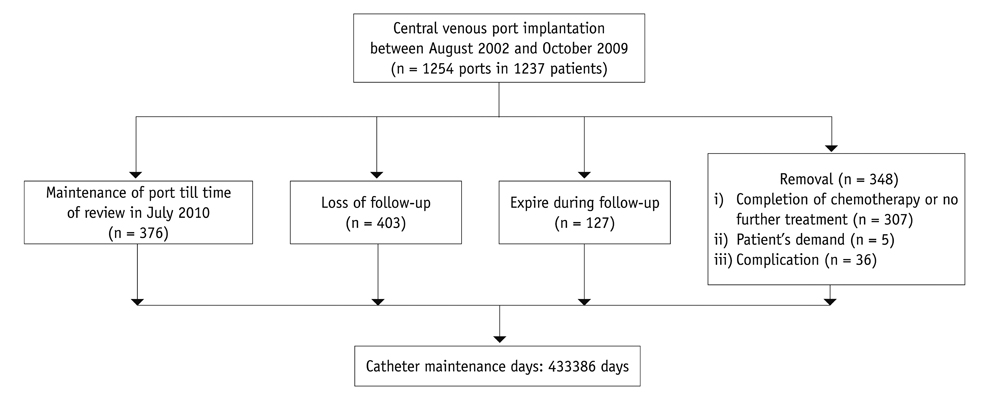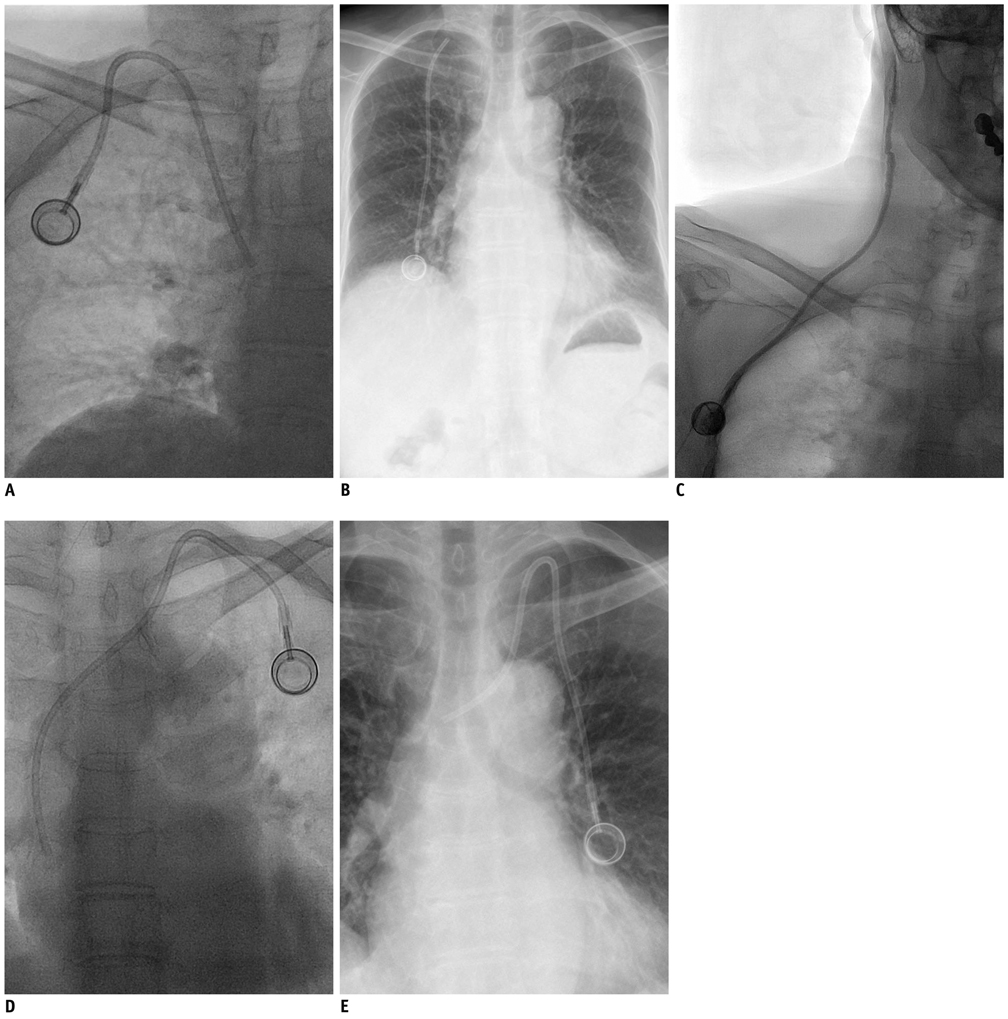Korean J Radiol.
2012 Jun;13(3):314-323. 10.3348/kjr.2012.13.3.314.
Ultrasound and Fluoroscopy-Guided Placement of Central Venous Ports via Internal Jugular Vein: Retrospective Analysis of 1254 Port Implantations at a Single Center
- Affiliations
-
- 1Department of Radiology, College of Medicine, Seoul National University, Seoul 110-744, Korea. angiointervention@gmail.com
- 2Department of Radiology, National Cancer Center, Goyang 410-769, Korea.
- KMID: 1372851
- DOI: http://doi.org/10.3348/kjr.2012.13.3.314
Abstract
OBJECTIVE
To assess the technical success and complication rates of the radiologic placement of central venous ports via the internal jugular vein.
MATERIALS AND METHODS
We retrospectively reviewed 1254 central venous ports implanted at our institution between August 2002 and October 2009. All procedures were guided by using ultrasound and fluoroscopy. Catheter maintenance days, technical success rates, peri-procedural, as well as early and late complication rates were evaluated based on the interventional radiologic reports and patient medical records.
RESULTS
A total of 433386 catheter maintenance days (mean, 350 days; range 0-1165 days) were recorded. The technical success rate was 99.9% and a total of 61 complications occurred (5%), resulting in a post-procedural complication rate of 0.129 of 1000 catheter days. Among them, peri-procedural complications within 24 hours occurred in five patients (0.4%). There were 56 post-procedural complications including 24 (1.9%, 0.055 of 1000 catheter days) early and 32 (2.6%, 0.074 of 1000 catheter days) late complications including, infection (0.6%, 0.018 of 10000 catheter days), thrombotic malfunction (1.4%, 0.040 of 1000 catheter days), nonthrombotic malfunction (0.9%, 0.025 of 1000 catheter days), venous thrombosis (0.5%, 0.014 of 1000 catheter days), as well as wound problems (1.1%, 0.032 of 1000 catheter days). Thirty six CVPs (3%) were removed due to complications. Bloodstream infections and venous thrombosis were the two main adverse events prolonging hospitalization (mean 13 days and 5 days, respectively).
CONCLUSION
Radiologic placement of a central venous port via the internal jugular vein is safe and efficient as evidenced by its high technical success rate and a very low complication rate.
Keyword
MeSH Terms
Figure
Reference
-
1. Niederhuber JE, Ensminger W, Gyves JW, Liepman M, Doan K, Cozzi E. Totally implanted venous and arterial access system to replace external catheters in cancer treatment. Surgery. 1982. 92:706–712.2. Biffi R, de Braud F, Orsi F, Pozzi S, Mauri S, Goldhirsch A, et al. Totally implantable central venous access ports for long-term chemotherapy. A prospective study analyzing complications and costs of 333 devices with a minimum follow-up of 180 days. Ann Oncol. 1998. 9:767–777.3. Cil BE, Canyiğit M, Peynircioğlu B, Hazirolan T, Carkaci S, Cekirge S, et al. Subcutaneous venous port implantation in adult patients: a single center experience. Diagn Interv Radiol. 2006. 12:93–98.4. Dede D, Akmangit I, Yildirim ZN, Sanverdi E, Sayin B. Ultrasonography and fluoroscopy-guided insertion of chest ports. Eur J Surg Oncol. 2008. 34:1340–1343.5. Gebauer B, El-Sheik M, Vogt M, Wagner HJ. Combined ultrasound and fluoroscopy guided port catheter implantation--high success and low complication rate. Eur J Radiol. 2009. 69:517–522.6. Teichgräber UK, Kausche S, Nagel SN, Gebauer B. Outcome analysis in 3,160 implantations of radiologically guided placements of totally implantable central venous port systems. Eur Radiol. 2011. 21:1224–1232.7. Araújo C, Silva JP, Antunes P, Fernandes JM, Dias C, Pereira H, et al. A comparative study between two central veins for the introduction of totally implantable venous access devices in 1201 cancer patients. Eur J Surg Oncol. 2008. 34:222–226.8. Biffi R, Pozzi S, Agazzi A, Pace U, Floridi A, Cenciarelli S, et al. Use of totally implantable central venous access ports for high-dose chemotherapy and peripheral blood stem cell transplantation: results of a monocentre series of 376 patients. Ann Oncol. 2004. 15:296–300.9. Karakousis CP. Surgical technique for totally implantable access ports (TIAP) needs improvement. J Surg Oncol. 2007. 95:180–181.10. Koroglu M, Demir M, Koroglu BK, Sezer MT, Akhan O, Yildiz H, et al. Percutaneous placement of central venous catheters: comparing the anatomical landmark method with the radiologically guided technique for central venous catheterization through the internal jugular vein in emergent hemodialysis patients. Acta Radiol. 2006. 47:43–47.11. Randolph AG, Cook DJ, Gonzales CA, Pribble CG. Ultrasound guidance for placement of central venous catheters: a meta-analysis of the literature. Crit Care Med. 1996. 24:2053–2058.12. Seiler CM, Frohlich BE, Dorsam UJ, Kienle P, Buchler MW, Knaebel HP. Surgical technique for totally implantable access ports (TIAP) needs improvement: a multivariate analysis of 400 patients. J Surg Oncol. 2006. 93:24–29.13. Lorch H, Zwaan M, Kagel C, Weiss HD. Central venous access ports placed by interventional radiologists: experience with 125 consecutive patients. Cardiovasc Intervent Radiol. 2001. 24:180–184.14. Moureau N, Poole S, Murdock MA, Gray SM, Semba CP. Central venous catheters in home infusion care: outcomes analysis in 50,470 patients. J Vasc Interv Radiol. 2002. 13:1009–1016.15. Yip D, Funaki B. Subcutaneous chest ports via the internal jugular vein. A retrospective study of 117 oncology patients. Acta Radiol. 2002. 43:371–375.16. Schutz JC, Patel AA, Clark TW, Solomon JA, Freiman DB, Tuite CM, et al. Relationship between chest port catheter tip position and port malfunction after interventional radiologic placement. J Vasc Interv Radiol. 2004. 15:581–587.17. Silberzweig JE, Sacks D, Khorsandi AS, Bakal CW;. Reporting standards for central venous access. J Vasc Interv Radiol. 2003. 14:S443–S452.18. Jan HC, Chou SJ, Chen TH, Lee CI, Chen TK, Lou MA. Management and prevention of complications of subcutaneous intravenous infusion port. Surg Oncol. 2010. [Epub ahead of print].19. Funaki B. Central venous access: a primer for the diagnostic radiologist. AJR Am J Roentgenol. 2002. 179:309–318.20. Biffi R, Orsi F, Pozzi S, Pace U, Bonomo G, Monfardini L, et al. Best choice of central venous insertion site for the prevention of catheter-related complications in adult patients who need cancer therapy: a randomized trial. Ann Oncol. 2009. 20:935–940.21. Chen PT, Sung CS, Wang CC, Chan KH, Chang WK, Hsu WH. Experience of anesthesiologists with percutaneous nonangiographic venous access. J Clin Anesth. 2007. 19:609–615.22. LaBella G, Kerlakian G, Muck P, Chung D, Vaughan A, Ritchison A. Port-A-Cath placement without the aid of fluoroscopy or localizing devices: a community hospital series. Cancer J. 2005. 11:157–159.23. Kurul S, Saip P, Aydin T. Totally implantable venous-access ports: local problems and extravasation injury. Lancet Oncol. 2002. 3:684–692.24. Kusminsky RE. Complications of central venous catheterization. J Am Coll Surg. 2007. 204:681–696.25. Lefrant JY, Cuvillon P, Bénézet JF, Dauzat M, Peray P, Saïssi G, et al. Pulsed Doppler ultrasonography guidance for catheterization of the subclavian vein: a randomized study. Anesthesiology. 1998. 88:1195–1201.26. Hinke DH, Zandt-Stastny DA, Goodman LR, Quebbeman EJ, Krzywda EA, Andris DA. Pinch-off syndrome: a complication of implantable subclavian venous access devices. Radiology. 1990. 177:353–356.27. Funaki B, Szymski GX, Hackworth CA, Rosenblum JD, Burke R, Chang T, et al. Radiologic placement of subcutaneous infusion chest ports for long-term central venous access. AJR Am J Roentgenol. 1997. 169:1431–1434.28. Sticca RP, Dewing BD, Harris JD. Outcomes of surgical and radiologic placed implantable central venous access ports. Am J Surg. 2009. 198:829–833.29. Hsieh CC, Weng HH, Huang WS, Wang WK, Kao CL, Lu MS, et al. Analysis of risk factors for central venous port failure in cancer patients. World J Gastroenterol. 2009. 15:4709–4714.30. Maki DG, Kluger DM, Crnich CJ. The risk of bloodstream infection in adults with different intravascular devices: a systematic review of 200 published prospective studies. Mayo Clin Proc. 2006. 81:1159–1171.31. Samaras P, Dold S, Braun J, Kestenholz P, Breitenstein S, Imhof A, et al. Infectious port complications are more frequent in younger patients with hematologic malignancies than in solid tumor patients. Oncology. 2008. 74:237–244.32. Goossens GA, Stas M, Jérôme M, Moons P. Systematic review: malfunction of totally implantable venous access devices in cancer patients. Support Care Cancer. 2011. 19:883–898.33. Vandoni RE, Guerra A, Sanna P, Bogen M, Cavalli F, Gertsch P. Randomised comparison of complications from three different permanent central venous access systems. Swiss Med Wkly. 2009. 139:313–316.34. Frank JL, Garb JL, Halla B, Reed WP Jr. Ionic implantation of silicone chronic venous access devices does not alter thrombotic complications: a double-blinded, randomized clinical trial. Surgery. 2001. 129:547–551.35. Heye S, Maleux G, Goossens GA, Vaninbroukx J, Jerôme M, Stas M. Feasibility and Safety of Endovascular Stripping of Totally Implantable Venous Access Devices. Cardiovasc Intervent Radiol. 2011. [Epub ahead of print].36. Luciani A, Clement O, Halimi P, Goudot D, Portier F, Bassot V, et al. Catheter-related upper extremity deep venous thrombosis in cancer patients: a prospective study based on Doppler US. Radiology. 2001. 220:655–660.37. Shin BS, Ahn M. Implantable central venous chemoport: comparision of results according to approach routes and methods. J Korean Radiol Soc. 2003. 49:165–171.38. Kim SS, Kim HP, Bae JI, Won JH. Evaluation of the necessity of port fixation in central venous port implantation. J Korean Soc Radiol. 2010. 63:217–220.39. Akl EA, Kamath G, Yosuico V, Kim SY, Barba M, Sperati F, et al. Thromboprophylaxis for patients with cancer and central venous catheters: a systematic review and a meta-analysis. Cancer. 2008. 112:2483–2492.
- Full Text Links
- Actions
-
Cited
- CITED
-
- Close
- Share
- Similar articles
-
- Internal jugular vein thrombosis detection by ultrasound scan after failure of internal jugular vein catheterization: A case report
- Radiologic Placement of Implantable Chest Ports in Pediatric Patients Under Sedation
- Implantable Central Venous Port: Comparison between Interventional Radiological Procedure and Surgical Procedure
- Interventional Treatment of Chemical Pleuritis and Hemothorax Caused by Iatrogenic Internal Jugular Vein Perforation after Central Venous Port System Implantation: A Case Report
- Radiologically-Placed Venous Ports in Children Under Venous Anesthesia



